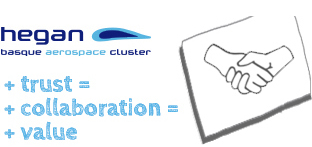Presentation
Presenting HEGAN’s annual report is always a great source of pride. For another year running, we represent a group that has been able to continue contributing to the development of the economy and of the aviation and aerospace industry in particular.
With a growth in turnover of more than 10% compared to 2014, the member organisations of the Basque Aeronautics and Space Cluster - HEGAN - had a good year in 2015 with total sales figures amounting to 1,935 million euros in all their plants throughout the world. The aerospace sector now represents 6.1% of the Basque Country’s industrial GDP.
For the third consecutive year, total exports passed the 1,000 million euro mark, reaching a figure of 1,226 million euros and representing 65% of total turnover. Companies located in Germany are the main destinations for our products, followed by those in the United Kingdom and the United States.
R&D investment has held its own compared to the previous year, in line with the phases of the different programmes that we are involved in, and has reached 162.5 million euros, which represents 9.4% of our turnover. Of that amount, the high level of self-financing practiced by our companies amounts to some 86%.
With regards to overall employment, this has fallen, mainly abroad, by 0.9% as a result of reductions in certain work packages by clients. In the Basque Country, the number of jobs is virtually the same, with 4,225 directly employed professionals and more than 14,300 indirect jobs.
Moreover, with regard to the future, the major airlines forecast an annual increase in demand of 5% over the next 20 years, which always involves an increase in the production of aircraft.
In the medium and long term, the situation of airlines and manufacturers provides a stable framework for the further development of the aviation industry, with an annual increase of 5% in passenger traffic over the next 20 years. This demand will continue to contribute to increased aircraft production. Our optimistic predictions for the next decade are based on large ongoing programmes, which will ensure high manufacturing activity throughout the industry’s value chain. According to different manufacturers, until 2033 there will be a need to build between 32,000 and 38,000 new commercial aircraft with more than 100 seats. In practice, this will mean doubling the current fleet. In the regional aircraft segment, from 70 to 130 seats, it is estimated that there will be a demand for between 6,250 and 7,000 units over the next 20 years (2014-2033) in order to cover the increases in market demand and to replace older aircraft.
Logically, the sector aims to continue maintaining and improving its competitiveness. Among the main challenges that we face, one of the most important issues is the increasingly rapid development of the sector, which is characterised by ever greater technological demands (greater aircraft safety, more environmentally friendly aircraft that are lighter and consume less) that have a profound impact on the chain. Moreover, we must seek to maintain the leadership of Tier-1 companies in technology and innovation and develop the value chain, so that all agents contribute to our aim of securing an excellent industry. Some of the variables to be taken into account now and in the future include: the need for specific financial means in order to be able to launch new programmes, the development of good relations with professionals in order to increase competitiveness with the cooperation of all involved and the continued diversification of the portfolio of companies, with their entry into new aeronautical markets and programmes, by taking advantage of large manufacturers outsourcing their work.
The HEGAN Association maintains its commitment to helping to find solutions through cooperation. We invite you to read about these aspects and the main activities of our associates, as set out in this document.
Many thanks.



